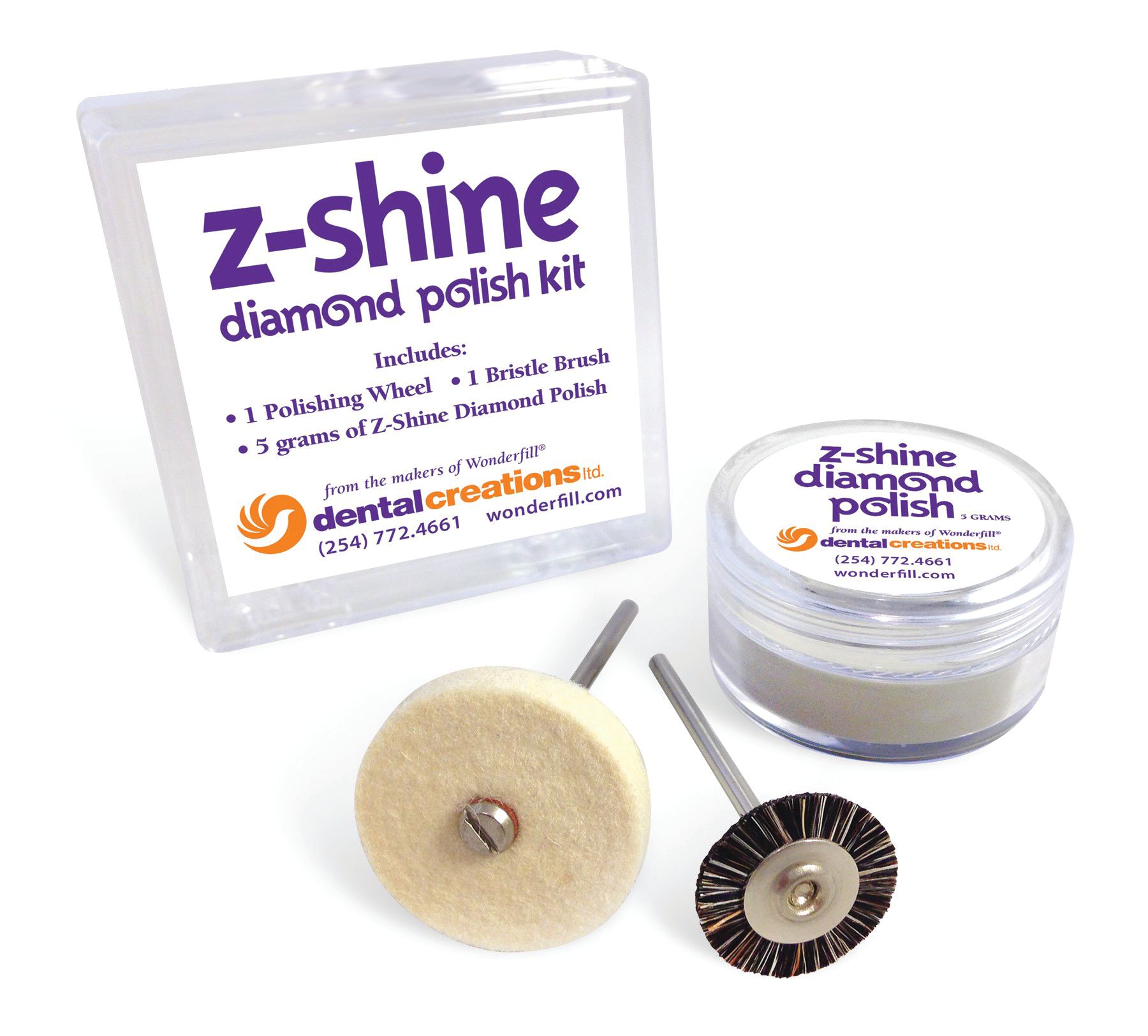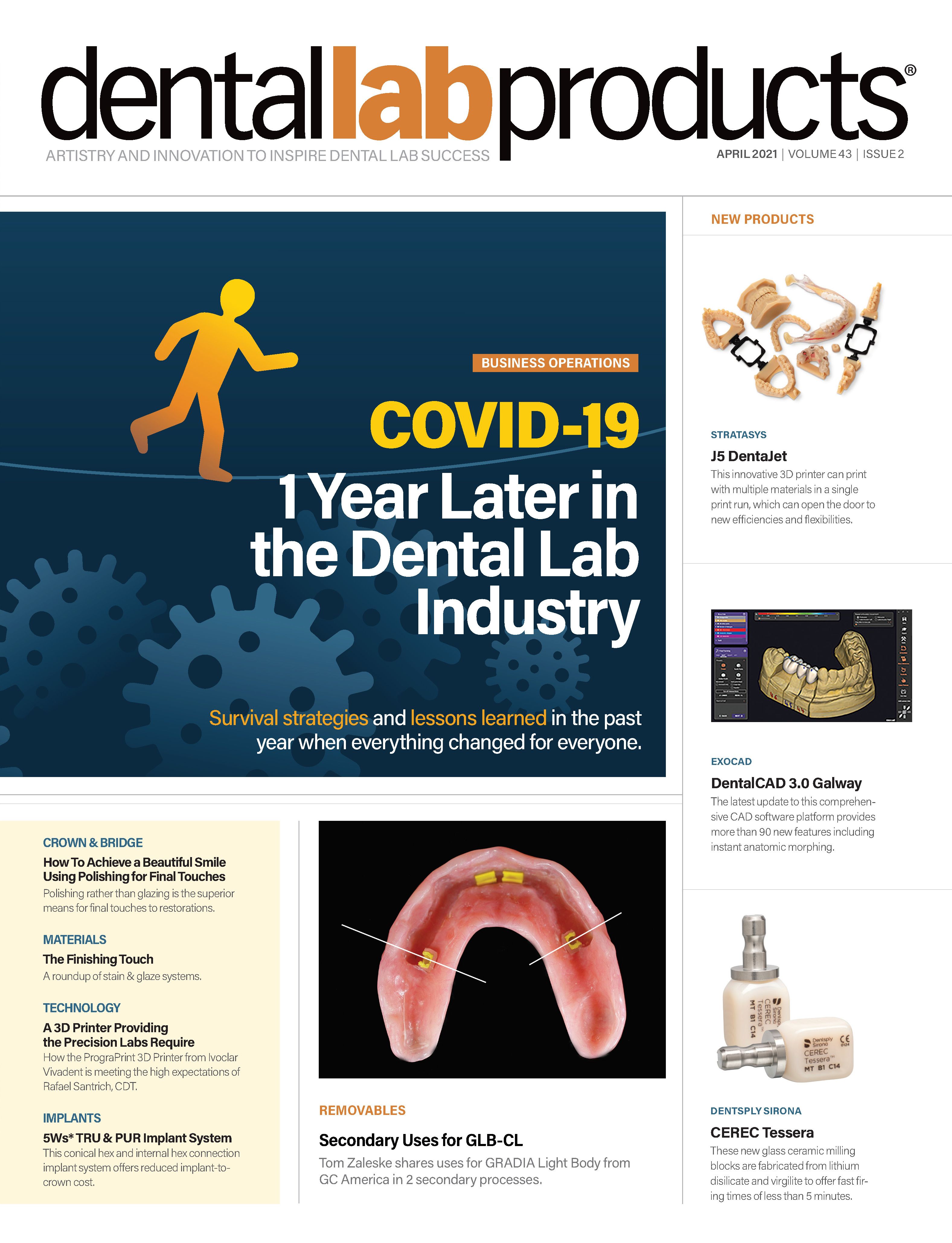The art of creating a beautiful smile lies with the lab technician’s finishing touches. Thus, the debate of glazing versus polishing continues.
John O. Burgess, DDS, MS, of the University of Alabama at Birmingham, and Gordon Christensen, DDS, PhD, MSD, founder and CEO of Practical Clinical Courses, cofounder and CEO of Clinicians Report Foundation, and a practicing prosthodontist, have extensive experience and knowledge regarding diamond-polished surfaces versus surface glazing on ceramic restorations.
Numerous studies have successfully proven the tissue response to glazed versus polished porcelain is significantly different.1 Glazed zirconia will have more material and antagonist wear than the zirconia that was polished.
Z-Shine Diamond Polish Kit
In 1 step in 30 seconds or less, receive a high-gloss finish on all restorations, including hybrid composites, pressed ceramics, and full contour milled zirconia. Kit includes 5 grams of diamond polish, No. 11 Soft Brush Wheel and 1-in-by-1/8-in Felt Wheel.
ADVANTAGES:
- One-Step, High-Luster Polish
- 30 Seconds or Less Polish Time
- Easy Cleanup (20 seconds)
- Water Soluble
- Use With Any Restoration Material
- Especially Designed for IPS e.max and Zirconia Crowns
Dental Creations, Ltd
254-772-4661
dentalcreationsltd.com
The surface glazed layer will have significant loss and result in an abrasive surface. This roughness on the surface will begin to erode the opposing teeth, giving a chiseled appearance. In contrast, polished zirconia is wear-friendly to the opposing teeth. The polished zirconia does not fracture like the glazed layer and takes on the appearance and characteristics of a file with a beautiful finish. As the studies are extensively unveiling, the requests for polished occlusal surfaces with no surface glaze continue to increase.
Initially, when Z-Shine Diamond Polish was announced to the lab technicians as the 1-step high-luster, shine-finishing diamond polish, it was met with skepticism. The standard diamond polishing process has a minimum of 2 smoothing steps, then use of a felt wheel on the broad surfaces, followed by the final burdensome step of cleaning the polished units. The challenge came for me when I got to the occlusal surface anatomy. This part was difficult and took more time than I expected, compared to applying surface glaze and firing. Dental Creations, Ltd.’s Z-Shine Diamond Polish has simplified the process for all technicians.
I am confident in Z-Shine Diamond Polish because it is the best I have ever used. When I was beginning to experiment with this diamond polish, I found that it works best by either dipping the polish in a small bowl of water or using a water spray to keep the surface wet. Now, every time I go to add a high-luster polish on an IPS e.max from Ivoclar Vivadent or milled zirconia after the contacts have been completed, I only need a No. 11 soft bristle brush wheel, Z-Shine Diamond Polish, and a slight amount of water to keep the surface wet to obtain the beautiful finish.
Today, dental ceramic materials are much different. This polish was specifically designed for today’s materials. I realized it when I was able to get the mirror shine on the labial surface of a maxillary central in 15 seconds and it only took 2 minutes to put a complete high-luster shine on a full contour molar that included the occlusal surface anatomy as well.
The Steps
A unique quality of Z-Shine is that, if you want to create a specific surface patina, all you need is a fine diamond bur. Also, when you use a No. 11 soft brush wheel, Z-Shine will polish the surface without obliterating the fine surface detail of the porcelain. Dental Creations sells a kit with the polish, and it includes a small felt wheel to assist in obtaining a mirror finish on the surface porcelain.
Z-Shine facilitates a radiant shine without overpolishing the surface, leaving a tooth enamel surface feel. For example, Z-Shine can be used to do the final polish on a milled zirconia crown with no surface staining or glazing (Figure 1). Also, the layered lithium disilicate laminates on teeth Nos. 6 to 11 (Figure 2) are not surface glazed. To achieve a natural surface luster finish on a lithium disilicate or zirconia restoration, use the No. 11 soft brush wheel in the kit in conjunction with the Z-Shine.
Teeth Nos. 6 and 7 (Figure 3) are single crowns with layered zirconia using VITA VM9 all-ceramic veneering porcelain, followed by surface finishing with the No. 11 brush wheel that is included in the Z-Shine kit. In the same figure, the bridge on teeth Nos. 8 to 11 is a full-contour zirconia/anterior high translucent without glaze. The lower restorations on teeth Nos. 22 to 27 are layered anterior porcelain feldspathic jackets that are finished with Z-Shine.
The layered lithium disilicate restoration on tooth No. 10 (Figure 4) matches the natural teeth next to it, thanks to the Z-Shine Diamond Polish. Once the surface luster you decide is obtained, the Z-Shine can be rinsed off quickly with a toothbrush and water. I polish all zirconia and lithium disilicate with Z-Shine Diamond Polish from Dental Creations, Ltd.
Unquestionably, polishing is in the best interest of the patient. Polishing rather than glazing is the superior means for final touches to restorations, resulting in a beautiful smile and a happy patient.
Reference
1. Brunot-Gohin C, Duval JL, Azogui EE, et al. Soft tissue adhesion of polished versus glazed lithium disilicate ceramic for dental applications. Dent Mater. 2013[29(9):e205-e212. doi: 10.1016/j.dental.2013.05.004.

